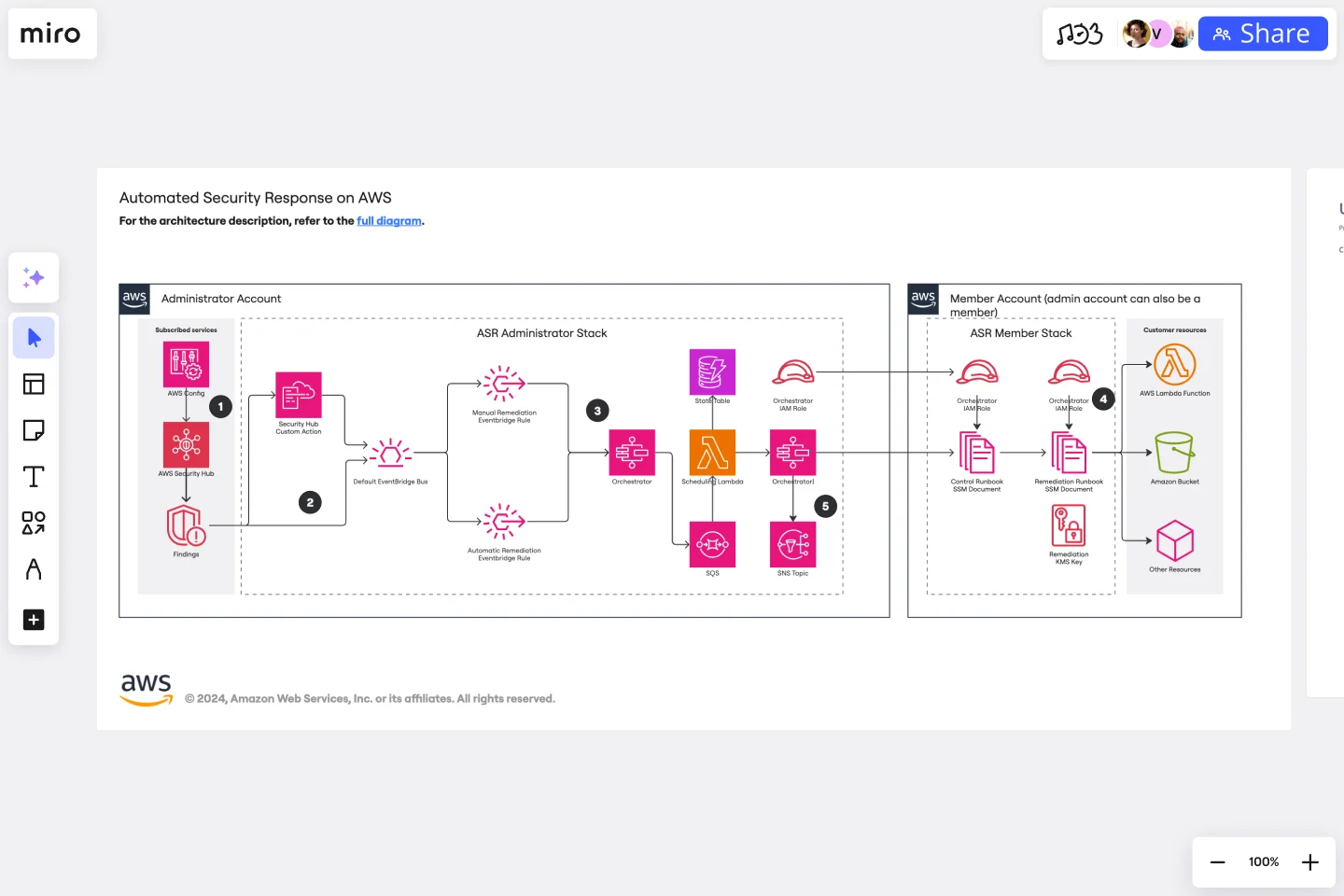Automated Security Response on AWS Template
Use the Automated Security Response on AWS template to improve AWS security by automating the detection and response to security threats, ensuring minimal manual intervention, and safeguarding infrastructure against evolving threats.
Available on Enterprise, Business, Education plans.
About the Automated Security Response on AWS Template
The Automated Security Response on AWS template is a strategic tool designed to enhance the security posture of AWS environments. This template facilitates the automated response to security incidents, ensuring that potential threats are swiftly identified and mitigated with minimal manual intervention. By using AWS's robust security services and features, the template allows for the creation of a responsive and resilient security framework.
How to use the Automated Security Response on AWS Template in Miro
Customization: Once the template is opened in Miro, you can customize it according to your specific AWS environment and security requirements. The template is designed to be flexible, allowing for adjustments to fit various security scenarios.
Integration with AWS: For the template to function effectively, integrate it with your AWS account. This involves setting up AWS Lambda functions, Amazon CloudWatch Events, and other AWS services that the template utilizes to automate security responses.
Simulation and testing: Before deploying the template in a live environment, simulate security incidents to test the automated responses. This ensures that the template is configured correctly and can handle real-world security threats.
Deployment: After thorough testing and customization, deploy the template to start automatically monitoring and responding to security incidents in your AWS environment.
Continuous improvement: Regularly review the automated responses triggered by the template and make necessary adjustments. Security threats evolve, and so should your automated responses to stay ahead.
Why use the Automated Security Response on AWS Template
Enhanced security: Automates the detection and response to security threats, reducing the risk of significant impact on your AWS environment.
Efficiency: Minimizes the need for manual intervention, allowing your security team to focus on strategic tasks rather than constantly monitoring for threats.
Scalability: Easily scales with your AWS environment, ensuring that security measures are consistently applied, no matter the size of your operations.
Customization: Offers flexibility to tailor the security responses based on the unique needs and configurations of your AWS environment.
Rapid response: Significantly reduces the response time to security incidents, limiting potential damage and exposure.
This template is a valuable asset for organizations looking to bolster their AWS security posture through automation and proactive incident response strategies.
Get started with this template right now. Available on Enterprise, Business, Education plans.
Web Diagram Template
Miro's Web Diagram Template simplifies complex project organization and promotes effective communication. It allows users to easily connect elements and gain a comprehensive understanding of complex relationships, making it a versatile and invaluable asset for diverse projects.
Security Automations for AWS WAF Template
The Security Automations for AWS WAF template is designed to streamline the process of enhancing the security of your AWS applications. It allows teams to collaboratively design, visualize, and refine AWS WAF configurations to protect against common web exploits effectively. This template includes various components such as automated deployment pipelines, instance schedulers, and serverless image handlers, providing a robust framework for managing AWS WAF security automations. By using this template, teams can improve collaboration, achieve a clear visual representation of their AWS WAF configurations, enhance efficiency in managing AWS WAF rules, and customize the template to meet specific application security needs.
ERD Customer Relationship Management (CRM) Template
Works best for:
ERD, CRM
The ERD Customer Relationship Management (CRM) template streamlines and enhances the management of customer relationships within businesses. It focuses on organizing customer information and interactions in a visually intuitive manner. Key entities such as Customer, Interaction, Sales Opportunity, Product, and Support Ticket are central to the template, facilitating the tracking of customer relationships, sales funnel activities, product purchases, and customer service interactions. This structured approach is critical for boosting customer satisfaction and optimizing sales strategies, making the ERD CRM template an invaluable asset for businesses aiming to improve their CRM processes.
UML Class Content Management System (CMS) Template
Works best for:
UML
The UML Class Content Management System CMS Template simplifies documenting and designing the architecture of a Content Management System. It allows for the creation of UML class diagrams to visualize the structure of a CMS. Teams can efficiently map out key classes and their interactions, such as how users create, manage, and publish digital content. The template's integration into Miro's collaborative platform allows for real-time teamwork, customization, and easy sharing of feedback. This streamlines the documentation process and is valuable for software development projects aiming to develop or refine a CMS.
Spaghetti Diagram Template
Works best for:
Operations, Mapping, Diagrams
Spaghetti diagrams are valuable for finding connections between assets, services, and products, as well as identifying dependencies in a visual way. Use this template to get an overview of a process and quickly find areas of improvement.
Interactive Video Storyboard Canvas
Works best for:
Diagramming
The Interactive Video Storyboard Canvas template offers a visual framework for planning and storyboarding interactive video content. It provides elements for outlining scenes, defining interactions, and visualizing user pathways. This template enables teams to design engaging and immersive video experiences, facilitating collaboration and alignment among content creators and stakeholders. By promoting creativity and interactivity, the Interactive Video Storyboard Canvas empowers teams to create compelling video narratives that captivate audiences and drive engagement.
